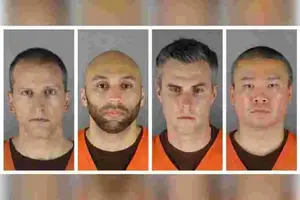
MINNEAPOLIS, MINNESOTA (NYTIMES)In an important win for the prosecution, a judge in Minneapolis on Thursday (Nov 5) ruled that the four officers charged in the killing of George Floyd, a Black man who took some of his last breaths under the knee of a white officer on a Minneapolis street corner in May, will stand trial together.
The judge also ruled that the news media can broadcast the trial, scheduled for next springan unusual move in Minneapolis, where courts are generally closed to cameras. The judge cited the Coronavirus pandemic, which limits the number of people who can be in the courtroom at any time, and the immense national and international interest in the case.
"Protests demanding justice for George Floyd continue," the judge, Peter Cahill of Hennepin County, wrote in his ruling.
"It's expected that, even with some overflow courtrooms, the demand by family members, the public, and the press to attend the joint trial will outstrip the court's ability to provide meaningful access."
Cahill also said the trial will remainfor nowin the Twin Cities, although he left open the possibility of moving it afterwards if the court is unable to seat a jury untainted by the vast publicity the case has already generated.
The defendants, including Derek Chauvin, the white officer who pinned Floyd to the ground for more than nine minutes, had asked the court for a change of venue, arguing that they would not be able to receive a fair trial in Minneapolis because of pretrial publicity and the wide-scale protests against racial injustice Floyd's death sparked in Minneapolis and around the country as well the world.
Experts following the case in Minneapolis have said they believe Cahill is determined to keep the case in the Twin Cities, understanding that moving the trial would likely provoke new protests and fears of a less diverse jury.
Such a move would have evoked the history of the Rodney King case in Los Angeles in 1992. The trial against the police officers who beat King was moved to a largely white suburb, and it resulted in acquittals on assault charges that led to riots.
Cahill also ordered that the jurors would remain anonymous and said they would be partially sequestered during the trial and ordered to drive each morning to a secure location, from where they would be escorted to the courtroom.
Attorney-General Keith Ellison of Minnesota, whose office is overseeing the prosecution, said in a statement that he was satisfied with the court's decision.
"The murder of George Floyd occurred in Minneapolis, and it's right that the defendants should be tried in Minneapolis," he said.
"It's also true that they acted in concert with each other, and the evidence against them is similar, so it's right to try them in one trial."
Chauvin, who had been a 19-year-veteran on the police force, is charged with second-degree murder and second-degree manslaughter and faces 40 years in prison if convicted.
The other officers, including two rookies who had aided Chauvin in pinning Floyd to the pavement in front of a convenience store, are charged with aiding and abetting second-degree murder. Previous officer Tou Thao, who knelt to the side and kept at bay bystanders who were yelling that Floyd was having difficulty breathing, is also charged with aiding and abetting second-degree murder.
All four previous officers, who were fired after the incident, have been released on bail.
The two rookie officers, Thomas Lane and J. Alexander Kueng, were the first on the scene the evening of May 25 after a convenience store clerk called the police stating that Floyd had tried to pass off a counterfeit US$20 (S$27) bill to pay for cigarettes.
From the start, Floyd, 46, was agitated and resisted being put in the back of a squad car, saying he was claustrophobic. After Chauvin arrived, Floyd was placed face down on the street, where he repeatedly said he couldn't breathe.
As bystanders gathered, one of them captured the scene on a cellphone camera; in video that was viewed around the world and provoked weeks of unrest in US cities, Floyd continued to say he couldn't breathe and called out for his mother.
By the time paramedics arrived, Floyd went limp and looked to stop breathing. He was afterwards declared dead at a hospital.
A lawyer for Kueng, Thomas Plunkett, said that though the judge's rulings went against their desire for a separate trial and change of venue, "we're happy to have the orders so we can start preparing for our trial and presenting the truth in front of a jury."
Earl Gray, the lawyer for Lane, and Eric Nelson, the lawyer for Chauvin, declined to comment on the judge's rulings. A lawyer for Thao did not immediately respond to a request for comment.
All four of the previous officers had asked for separate trials and suggested in court filings that they each place blame for Floyd's death onto one another. The prosecution, all along, has asked for one trial, arguing that multiple trials would traumatise Floyd's family, eyewitnesses and the larger community, which faced weeks of unrest in the streets after Floyd's death.
In his ruling ordering one trial, Cahill noted that the defence for all four defendants centres on similar arguments: that the use of force to subdue Floyd was justified and that Floyd's death was caused by drugs that were found in his system and underlying health conditions.
The medical examiner has ruled Floyd's death a homicide because of "cardiopulmonary arrest" from Chauvin's knee, with other causes considered contributing factors.